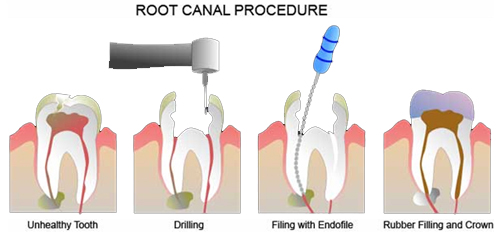|
What is root canal treatment?
Root canal treatment (also called endodontics) is needed when
the blood or nerve supply of the tooth (known as the pulp)
is infected through decay or injury.
Why is root canal treatment needed?
If the pulp becomes infected, the infection may spread through
the root canal system of the tooth. This may eventually lead
to an abscess. If root canal treatment (RCT) is not carried
out, the infection will spread and the tooth may need to be
taken out.
Does it hurt?
No. A local anaesthetic is used and it should feel no different
to having an ordinary filling done.
What does it involve?
The aim of the treatment is to remove all infection from the
root canal. The root is then cleaned and filled to prevent
any further infection. Root canal treatment is a skilled and
time-consuming procedure. Most courses of treatment will involve
two or more visits to your dentist. At the first appointment,
the infected pulp is removed. Any abscesses, which may be
present, can also be drained at this time. The root canal
is then cleaned and shaped ready for the filling. A temporary
filling is put in and the tooth is left to settle. The tooth
is checked at a later visit and when all the infection has
cleared, the tooth is permanently filled.
What will my tooth look like after treatment?
In the past, a root filled tooth would often darken after
treatment. However, with modern techniques this does not usually
happen. If there is any discolouration, there are several
treatments available to restore the natural appearance.
What if it happens again?
Root canal treatment is usually very successful. However,
if the infection comes back the treatment can be repeated.
What if I don't have the treatment?
The alternative is to extract the tooth out. Once the pulp
is destroyed, it can't heal and it is not recommended to leave
an infected tooth in the mouth. Although some people would
prefer an extraction, it is usually best to keep as many natural
teeth as possible.
Will the tooth be safe after treatment?
Yes. However, it is better to restore the tooth with a crown
to provide extra support and strength to the tooth.
What about aftercare?
Root-treated teeth should be treated just the same as any
other tooth. Remember to clean your teeth at least once a
day, preferably with fluoride toothpaste. See your dentist
for regular check-ups.
Am I a candidate for root canal treatment?
Root canal patients usually suffer tooth pain that is caused
by an infected tooth and severe pulp damaged that is usually
caused by an untreated cavity. If you have any tooth pain
you should visit your dentist for a consultation.
Why is root canal treatment done?
If a tooth’s pulp, which contains nerves and blood vessels,
becomes infected or damaged because of decay or injury, root
canal treatment is often the only way to save your tooth and
repair the damage. Endodontic treatment cleans out the infected
pulp chamber and repairs the damage.
What are the indications for Endodontic treatment?
Any of the following symptoms or combination of these indicate
the need for endodontic intervention:
• Spontaneous pain or throbbing pain during or after
chewing
• Sensitivity to hot and cold foods or liquids.
• Severe decay or an injury (which can lead to an abscess
or infection).
How is root canal treatment done?
Root canal treatment begins by your dentist numbing the area
around the tooth to be treated. A hole is then drilled to
the pulp area through the top or back of the tooth, and the
canal is measured with an x-ray or electronic imaging to determine
how much filling material will be necessary. The diseased
pulp is removed, and the empty canal is cleaned out and filled.
After the procedure is completed, a temporary
filling or cap is placed over the tooth. After a few weeks,
if the tooth shows no signs of infection, the temporary filling
is removed and the tooth is capped with a permanent crown.

Is it necessary to cap the root canalled tooth?
Yes, after the root canal procedure the tooth becomes
nonvital or dead as the pulp or nerve of the tooth is removed.
This in turn causes the tooth to discolor making it unaesthetic
and more brittle which means it is now more prone to fracture
easily. This can lead to more complications, and so it is
always better to cap the tooth to restore its shape &
contour and to enhance esthetics and to prevent it from fracturing.
|


